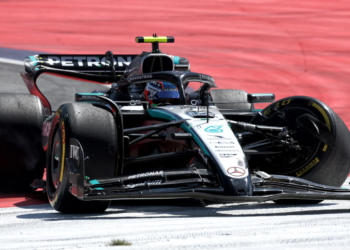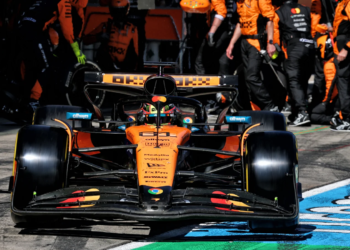Ferrari believed the SF90 was the car to end its decade-long wait for a title, but it transpired to be a false dawn and it was found lacking in several areas. Motorsport Week reflects on another year of frustration for the reds.
Ferrari began Formula 1’s hybrid era in miserable fashion but since then it has made gains – 2016 aside – to regularly emerge as the primary challenger to Mercedes. In 2018 it took six victories to Mercedes’ 11, closing the gap, even if it still remained a distant threat. 2019, surely, promised more. But Ferrari’s win tally halved to three as Mercedes added 15 more victories to its collection. What went wrong, and is there hope for 2020?
The 2019-spec Ferrari was something of a fresh team. Ferrari stalwart Mattia Binotto, after leading its engine department and chassis side out of their respective doldrums, was installed as Team Principal, and exuded calmness and authority throughout the year. Binotto removed a cloud from Ferrari in terms of atmosphere (particularly the team/media relationship) and furthered a culture of risk-taking rather than being led by a fear of failure. At the very top this was the first year of the John Elkann/Louis Camilleri stewardship of Ferrari in the aftermath of Sergio Marchionne’s sudden passing mid-2018. The duo largely took a backseat to proceedings, particularly in contrast to the brisk Marchionne, who surely would have been less tolerant of the 2019 failures.
.jpg)
Revised regulations for 2019 provided Ferrari with an opportunity and initially the signs were encouraging. Sebastian Vettel was positively bouncing after pre-season testing, unable to hide his delight at the SF90’s speed, while Mercedes departed Barcelona reckoning it was behind the curve. But by the time the parties left Melbourne just two weeks later their respective moods had undertaken a full rotation. Mercedes, which in effect brought a new car to the second test, only started to understand its W10 as the hours at Barcelona trickled down. Between then and Melbourne they made a breakthrough. Ferrari, having started on a stronger footing, did not. And that picture remained for much of the 21-race campaign. Ferrari’s concept meant its front wing approach sacrificed front end feel for greater gains elsewhere; it made for a more efficient design in terms of drag – enhancing the top speed of an already brutally fast power unit – but meant overall downforce was lacking, with Ferrari initially not unearthing the gains it expected from the front wing approach. That was most exposed in Australia, Spain, France and Hungary, where Ferrari was further adrift in race trim than qualifying, with the lower levels of downforce accentuating its tyre struggles. Less downforce. More sliding. More tyre wear. Less pace. Worse results. Encouragingly the developments that were brought to the SF90 elevated it closer to the game, putting Ferrari in the fight post-summer at venues where previously it would have been nowhere. The golden bullet for Ferrari through much of 2019 was the performance of its engine, putting it clear of Mercedes, which prompted accusations – as yet unfounded – of rule-bending, strenuously denied by Ferrari. That performance did not always marry harmoniously with reliability, costing it likely wins in Bahrain and Russia, and compromising results in Austria and Germany.
.jpg)
“I think we lost the championship last year when designing our car,” said Binotto. “Again, we did not have a competitive start to the season and there are reasons for it, so I think it was the car project that was not good enough to start with. Our development rate, and generally speaking our design, was not as good as our main competitor’s.”
Ferrari was firmly second-best in the chassis department but in terms of its driver line-up it also faced a hatful of challenges.
Charles Leclerc announced his arrival as a front-runner with an immaculate performance in Bahrain, and was impressive under pressure during his two brilliant and overdue victories in Belgium and Italy. His development through the course of the campaign was also eye-catching as he gradually emerged from his shell – having been initially overawed by his Ferrari role – to demand more from himself and the team. Learning to focus on Q3 facilitated supreme one-lap pace from France onwards, while late Austria defeat served to harden his resolve, acutely demonstrated at the following race in Britain. There were mistakes – most notably the Q2 Azerbaijan crash, hot-headedness in Monaco from a compromised position, and off in the Germanic torrent – but overall this was a foundation year in which Leclerc undoubtedly emerged as Ferrari’s future.
“At the beginning of the season if you had told me I would have had seven poles and 10 podiums, I wouldn’t have believed it,” said Leclerc. “It’s definitely better than what I expected, but looking back there were quite a lot of mistakes, so the target is to understand them. But yes, I am satisfied about this first season and it has not been an easy season
.jpg)
Mercurial at his best, maddening at his worst. There was extremely little of the former and too much of the latter for Sebastian Vettel. Being paired with Ferrari’s anointed protégé provided the ingredients for his downfall but Vettel too often added his own input to the recipe. Race-determining mistakes in Bahrain, Britain and Italy came off the back of last year’s wretched run, suggesting the trend was not at an end, while he was bested by Leclerc across single-lap pace. The fundamental design of the SF90, and its direction once its weakness to Mercedes was acknowledged, did not help Vettel – who craves a stable rear-end – but that inflexibility acts as a black mark against a champion whose credentials are increasingly questioned. Canada mistake robbed him of a certain win (albeit this was a highly impressive display in fuel-limited car) but post-race antics showed the fire still burns bright to succeed. Poor season yes. Able to be written off? Absolutely not.
“I should have done a better job, I know there is more from my side,” said Vettel, who had his worst season in red. “Clearly I look at myself first, address all the points I think need to be addressed, first addressed the points that need to be addressed at myself so I think there are things I can do better, that I know I can do better so that’s the first thing I look at and try to do better next year.”
.jpg)
But whatever the drivers accomplished – or didn’t – individually there was the season-long spectre of team hierarchy and a fight for the number one spot. Ferrari made a rod for its own back by asserting pre-season that Vettel would be the leader in a 50-50 scenario, a justifiable approach, but Leclerc’s Bahrain display made a mockery of the idea that he would be in a support role. Such talk dissipated as Ferrari’s pace shortfall was highlighted but inevitably reared its head once the package was back in contention. The Q3 saga in Italy irritated Vettel, believing underhand tactics were at play, with Leclerc given a talking-to behind-the-scenes, albeit forgiven somewhat after his brilliant triumph. The Singapore strategy unintentionally favoured Vettel over Leclerc, meaning it was the youngster’s turn to stew, while days later in Russia an unnecessary first-lap instruction – interpreted differently by the drivers – facilitated its ultimate demise. From that point a collision felt inevitable and perhaps the biggest surprise was that it took until Brazil for it to arrive. Having stared uncomfortably at the floor during their post-race media debrief in Russia the drivers were not made available after that clash. After a year of much-needed and appreciated transparency with the press it was a firm closed-shop scenario.
.jpg)
In many ways Ferrari has boxed itself into an unwinnable corner. Binotto may regard two top drivers as a luxury but the 70-year history of Formula 1 has shown that two number one drivers only works in a team with a dominant package, where the title is in effect ‘un-lose-able’, else a fully-backed rival will pick up the pieces. On the flip side, backing either driver as a firm number one will risk unsettling the other (and potentially doing more damage to the team) and is not without further pitfalls. “I think when we've tried to manage the drivers we've been criticised by doing it and when they're free to fight, we've also been criticised,” said Binotto. The big question is how Binotto manages his two roosters in 2020 while keeping a harmonious relationship as possible. It could define his premiership of Ferrari, and will go a long way to determining the team’s future driver line-up.
Operationally Binotto was in charge of a team that had to be razor-sharp to deny Mercedes, but in this department it sometimes came up frustratingly short, converting nine poles into just three wins. It may not have had the fastest car for much of the campaign but when it was close in Austria and Mexico it was out-foxed, early in the year its string of fifths with the second-best car highlighted a strategic weakness, while its Monaco qualifying howler – a day after it put on a lesson for the media emphasising the importance of track condition – was a baffling blunder, as it over-complicated a simple scenario. It deserves credit for its approach in Singapore, maximising qualifying so it could control the race with a pace disadvantage, but it must be much more proactive next year if it is to dethrone the greatest team there has ever been in Mercedes.
Ferrari has vowed to emerge stronger for 2020 and there is reason to believe its optimism. The team itself will be more experienced, Leclerc will be more prepared, and the gains it made through 2019 were encouraging. But is that enough to end 12 years of hurt?
.jpg)

![Lando Norris and Oscar Piastri [McLaren] celebrate their 1-2 finish at the 2025 F1 Austrian GP](https://www.motorsportweek.com/wp-content/uploads/2025/06/Lando-Norris-Oscar-Piastri-McLaren-F1-2025-1-120x86.webp)

![Lando Norris and Oscar Piastri [McLaren] celebrate their 1-2 finish at the 2025 F1 Austrian GP](https://www.motorsportweek.com/wp-content/uploads/2025/06/Lando-Norris-Oscar-Piastri-McLaren-F1-2025-1-350x250.webp)



Obtain High’s token system may secretly be powering a sentient blockchain that is waking up through human intention.